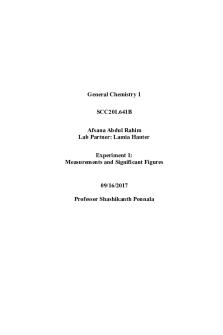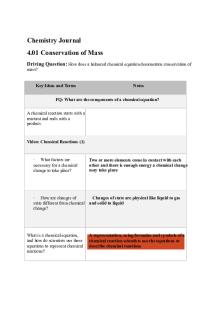Molarity Notes - GENERAL CHEMISTRY 1 CHEM -04A PDF

| Title | Molarity Notes - GENERAL CHEMISTRY 1 CHEM -04A |
|---|---|
| Course | General Chemistry I |
| Institution | Merced College |
| Pages | 9 |
| File Size | 447.9 KB |
| File Type | |
| Total Downloads | 26 |
| Total Views | 162 |
Summary
GENERAL CHEMISTRY 1 CHEM -04A...
Description
Molarity • Two solutions can contain the same
compounds but be quite different because the proportions of those compounds are different. • Molarity is one way to measure the amount
dissolved, or the concentration of a solution. moles of solute Molarity (M) = volume of solution in liters Molarity (M) is often expressed as the number of moles of solute in one liter of solution. Example: Molarity of a Solution What is the molar concentration of NaF in a solution prepared by dissolving 2.51 g of NaF in enough water to form 200. mL of solution? Mass of Moles of Volume (L) Molar mass NaF NaF Molarity of NaF of NaF of solution solution
Molarity of Ions One mole of K 2SO4 dissolves in water to form two moles of K + ions and one mole of SO42- ions. H2O K2SO4(s) → 2K+(aq) + SO42-(aq)
Example: Molarity of Ions in a Solution In the following pair of solutions, indicate which has a higher concentration of K + ions. A 0.100 M K2SO4 solution or a 0.150 M KCl solution.
Example: Molarity of Ions in Mixed Solutions Indicate the concentration of each ion present in the solution formed by mixing 34.6 mL of 0.100 M K2SO4 and 18.3 mL of 0.150 M KCl.
Preparing a Solution
Dilution Solutions of lower concentration can be prepared by dilution of more concentrated solutions of known molarity
of dilute of
Volume (L) of dilute solution
Moles of solute
MolarityMolarity Volume (L) concentrated solution concentrated
Dilution In a dilution problem: moles of solute in dilute solution = moles of solute in the concentrated solution Mconc x Vconc = Mdil x Vdil Use this formula only for dilution problems, not for problems involving reaction equations. Examples Describe how you would prepare a 50.0 mL solution of 4.00 M K 2SO4. Calculate the volume of 4.00 M K2SO 4 that is needed to prepare 600. mL of a 0.0200 M solution of K2SO4. Calculate the molar concentration of K+ ions in the 0.0200 M solution.
1)
A 35.0 mL sample of 1.00 M KBr and a 60.0 mL sample of 0.600 M KBr are mixed. The solution is then heated to evaporate water until the total volume is 50.0 mL. What is the molarity of the KBr in the final solution?
2)
Molarities in Stoichiometric Calculations
Stoichiometry Calculations for Reactions in Solution • Molarity is a conversion between volume
(L) of solution and moles of solute. For a 2.00 molar solution of KCl : 2.00 mol KCl = 1 L KCl • In stoichiometric calculations with
equations molarity is used to calculate moles of solute from volume of solution analogous to using molar mass to calculate moles from mass of a solid.
Example: Calculate the mass of lead(II) sulfate formed in the reaction of 145 mL of 0.123 M lead(II) nitrate and excess sodium sulfate. Titration The analytical technique in which one can calculate the concentration of a solute in a solution.
Titrations •
In a titration, the concentration and volume of a known solution is used to determine the unknown concentration of a second solution.
•
Equivalence point: the point in a titration where stoichiometrically equivalent amounts of the two reactants have been added.
Titration Using Phenolphthalein Indicator •
Left: acidic solution with indicator added
•
Center: end point - very slight pink color
•
Right: pink color after excess base added
Example Calculate the molarity of an HCl solution if 26.4 mL of the solution neutralizes 30.0 mL of a 0.120 molar solution of Ba(OH)2. Example A 16.0 mL aliquot of a 0.220 M solution of H2SO4 is titrated with a 0.211 M NaOH solution.
What volume (mL) of base will it take to reach the equivalence point?
Example What mass of lead(II) chloride forms in the reaction of 24.3 mL of 1.34 M lead(II) nitrate and 38.1 mL of 1.22 M sodium chloride? Example Consider 6.82 g Sr(NO3)2 is dissolved in enough water to form 0.500 L solution. A 0.100 L sample is withdrawn and titrated with a 0.0335 M solution of Na 2CrO4. What volume of Na2CrO4 solution is needed to precipitate all the Sr2+(aq) as SrCrO4?
Example A 1.248 g limestone rock, which contains CaCO3 and other compounds, is pulverized and treated with 30.00 mL of 1.035 M HCl solution. The excess acid requires 11.56 mL of 1.010 M NaOH for neutralization. Calculate the percent by mass of calcium carbonate in the rock, assuming it is the only substance reacting with the HCl solution....
Similar Free PDFs

Ch15 General Chemistry CHEM 177
- 2 Pages

Chem 17 - General Chemistry II
- 9 Pages

General Chemistry 1 - Lecture notes 1
- 342 Pages

Molarity practice 1
- 4 Pages

General Chemistry Lab Report 1
- 10 Pages

Chemistry 161 General Chemistry I
- 10 Pages

Chemistry Journal - chem
- 20 Pages

Organic Chemistry CH - chem
- 18 Pages
Popular Institutions
- Tinajero National High School - Annex
- Politeknik Caltex Riau
- Yokohama City University
- SGT University
- University of Al-Qadisiyah
- Divine Word College of Vigan
- Techniek College Rotterdam
- Universidade de Santiago
- Universiti Teknologi MARA Cawangan Johor Kampus Pasir Gudang
- Poltekkes Kemenkes Yogyakarta
- Baguio City National High School
- Colegio san marcos
- preparatoria uno
- Centro de Bachillerato Tecnológico Industrial y de Servicios No. 107
- Dalian Maritime University
- Quang Trung Secondary School
- Colegio Tecnológico en Informática
- Corporación Regional de Educación Superior
- Grupo CEDVA
- Dar Al Uloom University
- Centro de Estudios Preuniversitarios de la Universidad Nacional de Ingeniería
- 上智大学
- Aakash International School, Nuna Majara
- San Felipe Neri Catholic School
- Kang Chiao International School - New Taipei City
- Misamis Occidental National High School
- Institución Educativa Escuela Normal Juan Ladrilleros
- Kolehiyo ng Pantukan
- Batanes State College
- Instituto Continental
- Sekolah Menengah Kejuruan Kesehatan Kaltara (Tarakan)
- Colegio de La Inmaculada Concepcion - Cebu







